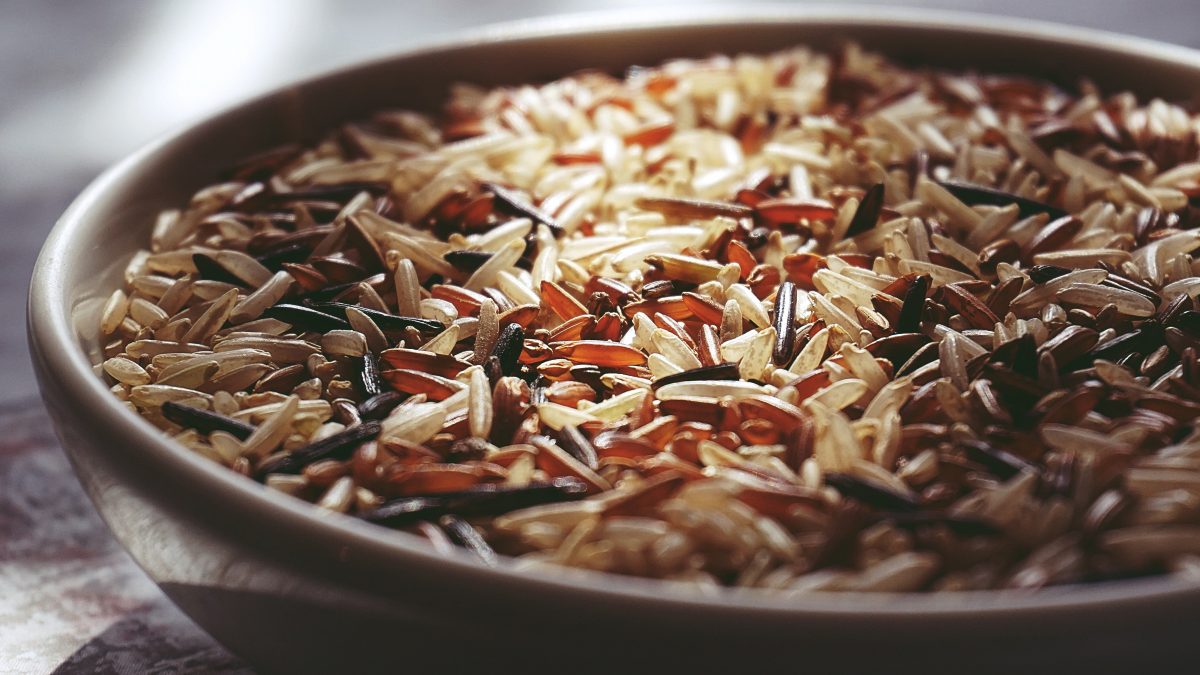Why does switching from white rice to brown rice enable overweight individuals to significantly reduce their weight, their waist size, their blood pressure, and the level of inflammation within their bodies? That’s the topic of my video Brown, Black, Purple, and Red (Unlike White on) Rice.
We think it might be the fiber. Brown rice has four times as much dietary fiber as white rice, including prebiotic types of fiber that foster the growth of our good bacteria, which may help account for the anti-obesity effects of brown rice.
Besides the prebiotic fiber, when brown rice is milled into white, there are all sorts of vitamins and minerals that also are lost, as well as phytonutrients such as gamma oryzanol, which may help shift one’s preferences to healthier foods. Petri dish studies suggest gamma oryzanol may help lower cholesterol. And, along with other compounds found in the rice bran, which is what makes brown rice brown, gamma oryzanol may inhibit human cancer cell growth through antioxidant means, anti‑proliferative and pro-cancer cell suicide mechanisms, immune system modulation, and increasing barrier protection. However, this was all seen in test tubes, not people.
There are two human studies, though. The Adventist Health Study found that brown rice was one of four foods associated with significantly decreased risk of colorectal polyps, which can turn into colorectal cancer. Eating cooked green vegetables every day was associated with 24 percent lower risk, which was as much as eating dried fruit just three times a week. Eating beans, chickpeas, split peas, or lentils at least three times a week was associated with 33 percent lower risk, but brown rice seemed to garner 40 percent lower risk, and that was just a single serving or more a week.
The other human study reported increased muscle strength after supplementation with a brown rice compound in hopes that it could provide a side effect-free alternative to anabolic steroids. The dose the researchers were giving, however, is equivalent to approximately 17 cups of brown rice a day, so it’s not clear if it works at practical doses.
Naturally pigmented rice, such as black rice and red rice, may be even more nutritious than brown rice. During the last decade, research has shown that these natural anthocyanin plant pigments may have a variety of beneficial effects. Anthocyanins are what make blueberries blue and red cabbage red. “Recent recognition of the fact that taking diet rich in plant foods lowers the risks of cancer promotes the enthusiasms in isolating…[these components as] pharmaceutical agents”—but why not just eat the blueberries or add some red cabbage to your stir fry atop some colorful rice?
Black, purple, and red rice—and their pigment compounds—have been found to be involved in a variety of antioxidant, anti-cancer, anti-heart disease, anti-diabetes, and anti-allergy activities, but these were all studies done in a lab. We don’t yet have clinical studies, but these pigmented rice varieties have everything that brown rice has, plus five times more antioxidants and a variety of extra benefits. That’s why I, or rather my rice cooker, has always cooked red, black, or purple rice with a handful of lentils or split peas thrown in for good measure, since they cook in the same time frame. If you see below to my arsenic in rice series you’ll note I’ve since diversified my grains.
But why don’t most people even choose brown over white? Well, brown rice does not last as long on the shelves, so it can actually be more expensive even though it’s less processed. White rice, on the other hand, is like food for the apocalypse, even putting Twinkies to shame. White rice was still edible after 30 years—though, by then, it may have a “slight playdough” odor.
For more on rice, see:
- Is It Worth Switching from White Rice to Brown?
- Alzheimer’s Disease: Grain Brain or Meathead?
- Kempner Rice Diet: Whipping Us Into Shape
- If White Rice Is Linked to Diabetes, What About China?
- Drugs and the Demise of the Rice Diet
- Can Diabetic Retinopathy Be Reversed?
- High Blood Pressure May Be a Choice
- Gut Microbiome: Strike It Rich with Whole Grains
I took a deep dive into the arsenic issue and produced a whole video series so everyone can make informed choices:
- Where Does the Arsenic in Chicken Come From?
- Where Does the Arsenic in Rice, Mushrooms, and Wine Come From?
- The Effects of Too Much Arsenic in the Diet
- Cancer Risk from Arsenic in Rice and Seaweed
- Which Rice Has Less Arsenic: Black, Brown, Red, White, or Wild?
- Which Brands and Sources of Rice Have the Least Arsenic?
- How to Cook Rice to Lower Arsenic Levels
- Arsenic in Infant Rice Cereal
- Arsenic in Rice Milk, Rice Krispies, and Brown Rice Syrup
- How Risky Is the Arsenic in Rice?
- How Much Arsenic in Rice Is Too Much?
- Is White Rice a Yellow-Light or Red-Light Food?
- Do the Pros of Brown Rice Outweigh the Cons of Arsenic?
And, for more on the potential wonders of the blue/black/purple anthocyanin pigments, check out these videos:
- Anti-Inflammatory Effects of Purple Potatoes
- Dietary Treatments for Computer Eye Strain
- How to Slow Brain Aging by Two Years
- Anti-Inflammatory Life Is a Bowl of Cherries
- The Antioxidant Effects of Açai vs. Apples
- The Benefits of Açai vs. Blueberries for Artery Function
In health,
Michael Greger, M.D.
PS: If you haven’t yet, you can subscribe to my free videos here and watch my live, year-in-review presentations:
- 2012: Uprooting the Leading Causes of Death
- 2013: More Than an Apple a Day
- 2014: From Table to Able: Combating Disabling Diseases with Food
- 2015: Food as Medicine: Preventing and Treating the Most Dreaded Diseases with Diet
- 2016: How Not To Die: The Role of Diet in Preventing, Arresting, and Reversing Our Top 15 Killers
